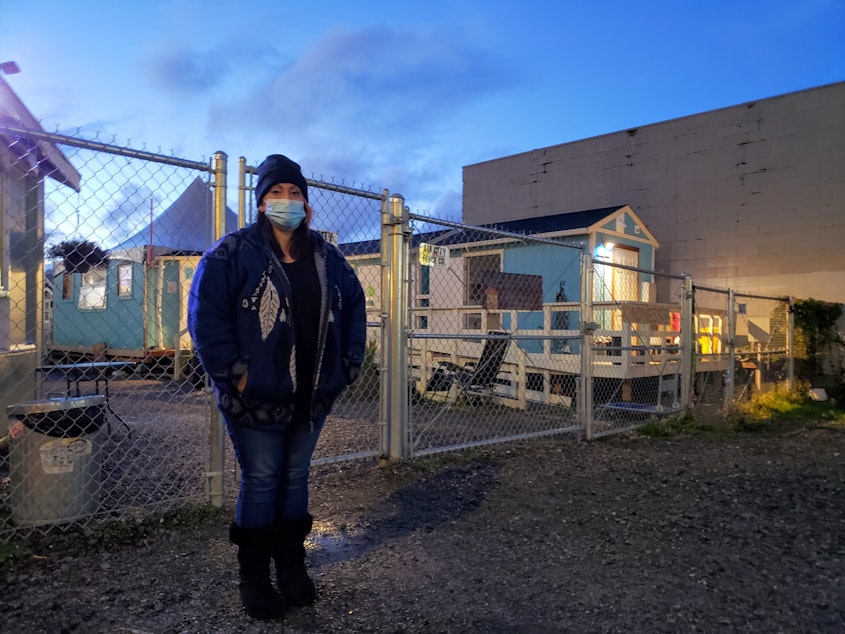A different Thanksgiving this year for Seattle's unsheltered community

People in Seattle experiencing homelessness are also making changes ahead of a pandemic holiday season. The traditional large meals are cancelled, but that’s not stopping the holiday spirit.
Outside of Interbay Village in lower Queen Anne, Michelle Crisafi said she's in charge of the decorating committee for the tiny house village.
"It's just me. I'm the only committee," Crisafi laughed. "So it'll look really festive here in a few days."
Before moving into Interbay, Crisafi had lived in The Jungle and other tent camps around SoDo. She moved into the village just five months ago. It’s a cluster of over 50 small, wooden cabins on a gravel lot right next to the Magnolia Bridge.
For the first time in six years, Crisafi has some place warm and dry for the holidays — and she wants to make it special.
"I've been asking everyone if they're gonna cook and I pretty much got a 'no' from everyone. So I'm recruiting helpers because when I was homeless, I made Thanksgiving by a campfire and fed everybody around me so I have to cook," she said.
Sponsored
Also new this year: Crisafi will be with her family. Her 19-year-old daughter and 1-year-old grandson also just moved into one of the tiny homes.
“I help with the care of him and I mean, it's amazing," Crisafi said. "So I don't feel like I'm losing anything. But I can't imagine how everybody else feels with no visitors. It's pretty crazy.”
The rest of Interbay is closed to visitors because of the pandemic, and that's a big change for the dozens of villagers.
“In years past we would often set up a potluck with dishes," said Andrew Constantino, site coordinator at Interbay. "And perhaps neighbors or volunteers who want to share the holiday with the the village community. It's definitely going to be different this year because of Covid."
Constantino said that in the three years the village has been set up, it's become a part of the community.
Sponsored
“It's a powerful experience and not being able to do that really sucks a little bit," he said.
The village has also had to cut back on volunteers. Constantino said that since the pandemic began, more people have wanted to help out at the village but just can't go inside now.
“A lot of people are out of work and so they're interested, and they're kind of engaged, but we can't really seize on it. So I think that it's frustrating for them and also for us," Constantino said.
The neighborhood is stepping up in new ways though, he added. For instance, more clothing has been donated this year. Additionally, one volunteer set up an Amazon wish list for the villagers. They're also getting a lot of food at a time when more people than ever are experiencing hunger in the region.
Beverly Graham helps coordinate Seattle’s emergency meal plan and runs Operation Sack Lunch, a nonprofit that makes thousands of meals a day for people experiencing homelessness. Before the pandemic, the group relied on food donated from restaurants and large businesses.
Sponsored
“At the beginning, we were rescuing enormous amounts of food from places that were closing down," Graham said. "You know, it wouldn't be unusual to get 70,000 pounds in one day. And and now we are purchasing those amounts of food to put out the the meals that we're doing.”
On top of having to buy more food these days, Graham said there’s so many extra steps. The biggest and most expensive: they have to package each individual meal.
“We have to cook the meal off, we have to cool it down, we have to put it into the to go containers, and then it's delivered out to their environments," she said.
Nevertheless, they'll start cooking and packing on Sunday for about 5,000 meals for Thanksgiving — their largest meal-making task yet.
By then, with help from her fellow villagers, Michelle Crisafi will have decorated Interbay Tiny Village, her new holiday home.
Sponsored
“It has to be festive. It has to be fun, you know — needs to feel like home," Crisafi said. "People are happier when they're fed. And if they feel like something is familiar, and they're warm, then the sky's the limit at that point.”
In January, more than 11,000 people were estimated to live outside in Seattle. It’s unclear how much that number has changed since the pandemic began.




